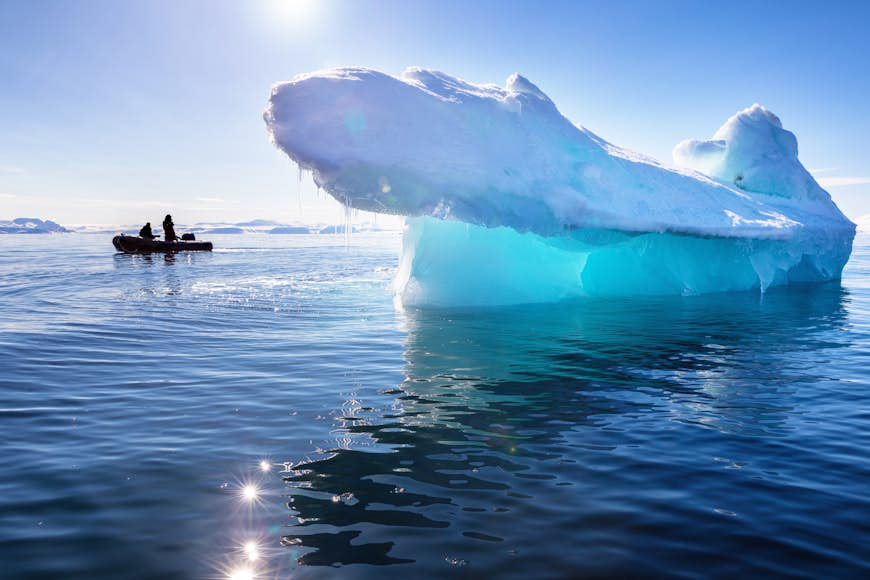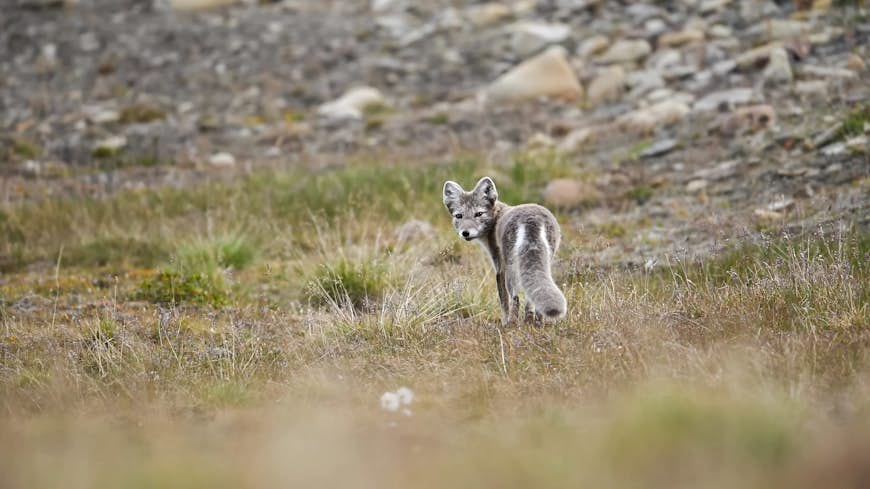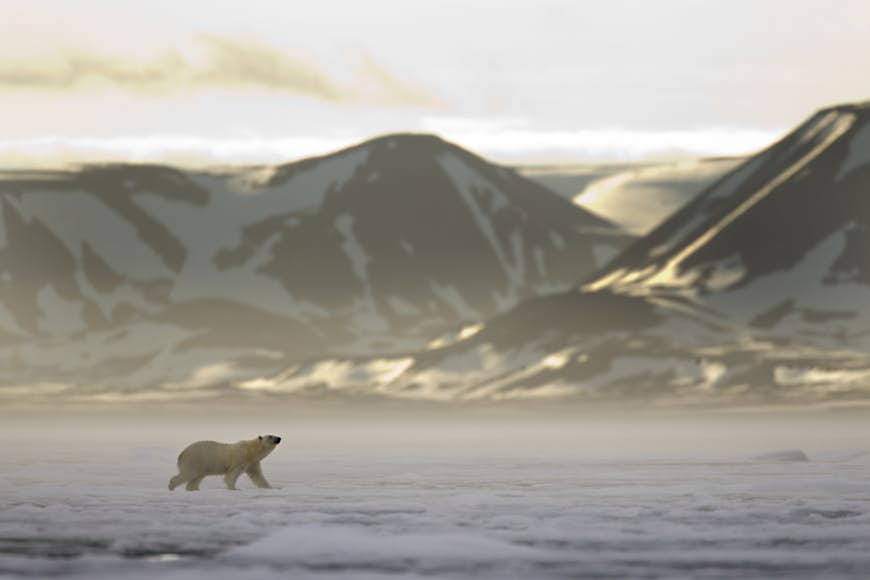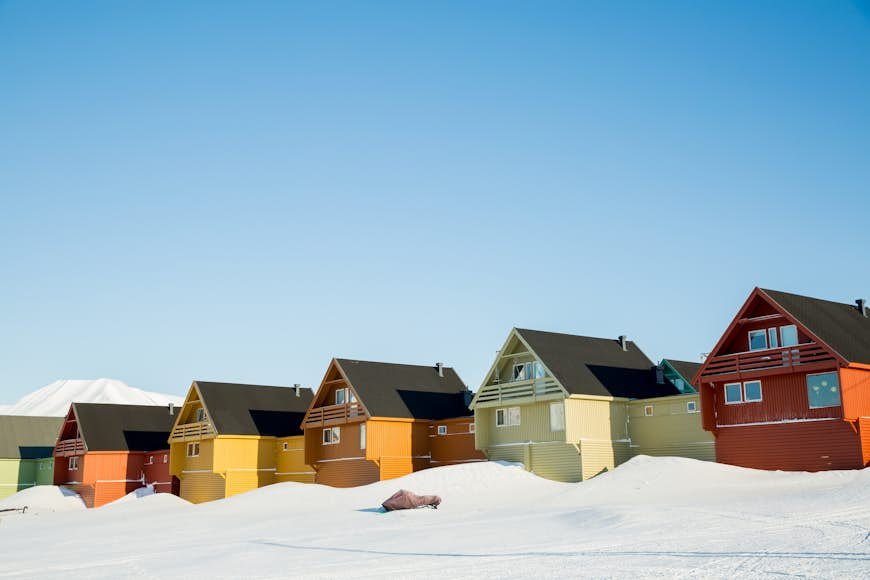
Your first visit to Svalbard may seem a bit daunting. Midway between Norway and the North Pole, this remote Norwegian island is a land of extreme climate, glaciers and polar bears. This, combined with Svalbard’s unique laws, can make it feel far removed from the rest of the world.
The Svalbard archipelago consists of three islands: Spitsbergen, Edgeøya and Nordaustlandet. Most of the tourist activity takes place on Spitsbergen, centered on the settlement of Longyearbyen. Accommodation is limited to mostly traditional hotels, although a small number of hostel rooms and self-catering apartments are available near Longyearbyen.
If you feel up for the adventure, here’s what you need to know about visiting Svalbard for the first time.
Scout new ways to explore the planet’s wildest places with our weekly newsletter delivered to your inbox.
Why you should visit Svalbard
If you’ve ever dreamed of waking up to a view of glaciers glittering in a sun that never sets or dog-sledding under the northern lights, Svalbard is the destination for you. Accessible from mainland Norway, this archipelago retains a real sense of adventure, and its main town, Longyearbyen, is a frontier outpost, poised on the edge of one of the harshest – and most awe-inspiring – wildernesses in the world.
Realistically, this is the farthest north most of us are ever likely to get. If you’re intrigued by the polar north, Svalbard should definitely be on your list. Wrap up and spend as much time as you can out in the wild landscape. Wildlife watching and glacier-spotting cruises or kayak trips are great in the summer or you can go on a hike with the proper safety precautions (remember, this is polar bear country). You can hop on a snowmobile or take a ride on a dog-sled at any time of year.
The wilderness and wildlife are the big lures, but there are some conventional sights to see too. Unfortunately, you can’t visit Svalbard’s remarkable Global Seed Vault without special permission, so you’ll have to make do with snapping a picture from afar. The fascinating Svalbard Museum is well worth a couple of hours of your time, with its displays on the life formerly led by whalers, trappers, seal and walrus hunters and miners.
For something a bit different, head to Svalbard Bryggeri, the northernmost brewery in the world. A tour with tastings costs 429 NOK and you can book in advance. If you can’t make it to the brewery, not every bar stocks the local beer, but you will be able to pick up some cans in a grocery store.
 Boat trips to photograph whales and icebergs are a popular way to explore Svalbard © Rixipix / iStockphoto / Getty Images
Boat trips to photograph whales and icebergs are a popular way to explore Svalbard © Rixipix / iStockphoto / Getty Images
Do I need a visa for Svalbard?
You do not need a visa to travel to Svalbard, though you may need a Norwegian visa to reach the islands. In fact, you do not even need a visa to work here! If you are truly captivated by your trip and wish to move north, it’s legal for anyone of any nationality to immigrate – you just need to acquire employment and housing prior to arriving.
Note that you will most likely be traveling to Svalbard via mainland Norway so you must meet the visa requirements for Norway if you’re passing through.
How do I get to Svalbard?
Both Norwegian Air and SAS fly from Oslo to Longyearbyen, and between the two carriers, you’ll be able to get a flight most days of the week. You can also get a flight from Tromsø – in fact, even if your flight says it is direct from Oslo, it may stop at Tromsø and you’ll have to disembark for passport control.
If you are connecting directly to Svalbard via Oslo airport, you should also be careful to check ahead to see if you need a Schengen visa for Norway as Svalbard is not part of the Schengen area.
 Look out for Arctic foxes, which change color from white to grey with the seasons © Banu R / iStockphoto / Getty Images
Look out for Arctic foxes, which change color from white to grey with the seasons © Banu R / iStockphoto / Getty Images
The best time to go to Svalbard
Most people visit Svalbard in the summer season (May to September). The snow starts to melt in May, making it easier to get around, and it’s a busier time for tourism, with more flights from Oslo and more cruise ships docking at Longyearbyen.
This is also the best time of year for wildlife watching. Come in June and you’ll have a good chance of spotting walrus, polar bears and even whales on a cruise. You’ll also be experiencing this under 24 hours of daylight until the end of August when the sun begins to set again. Overall, it’s an easier experience to visit during the warmer months.
That being said, Svalbard was made for adventurous travel. Some are drawn to Svalbard by the endless polar nights. The sun disappears entirely from the end of October to February but that doesn’t mean that Svalbard comes to a standstill – you can still enjoy activities such as snowmobiling and dog sledding, and there’s a good chance of spotting the northern lights. Just be sure to pack for the conditions – winter temperatures can drop as low as −20°C (−4°F).
Is it easy to get around Svalbard?
Public transport is almost non-existent in Svalbard, with the exception of the shuttle bus to Longyearbyen from the airport. The journey takes just minutes, and the bus is timed to coincide with all arrivals and departures and will drop you straight to your accommodation. A return ticket costs 170NOK.
Most visitors explore the area outside Longyearbyen on guided excursions, which often include transfers to and from your accommodation. For the most part, if you leave Longyearbyen, you’ll probably be with a tour guide, using their transport and following their safety precautions.
Arctic Autorent is the biggest car rental company in Svalbard and has an office at the airport. You can book ahead online, and prices start from 1090 NOK a day. However, you should note that roads are limited once you leave Longyearbyen; you will not be able to get to other settlements like Barentsburg or Ny-Ålesund by car. There are also two taxi services in Longyearbyen; call ahead and book if you want to get a lift somewhere.
The most common form of transport you’ll see in Svalbard is the snowmobile; one (or two!) of these vehicles are parked outside practically every home in Longyearbyen. Plenty of tour operators can arrange a rented snowmobile if you’d like to drive one yourself (electric models are often available). Guided tours can take you to ice caves, fjords and the active mining settlement of Barentsburg to see the industry that shaped Svalbard. There are also northern lights tours in winter.
Don’t let the Arctic weather stop you from exploring Longyearbyen on foot – the locals don’t! Getting hold of some crampons for your shoes will make this an easier endeavor.
 Polar bears are both the biggest attraction and the biggest danger in Svalbard © Paul Souders / Getty Images
Polar bears are both the biggest attraction and the biggest danger in Svalbard © Paul Souders / Getty Images
Safety precautions when leaving Longyearbyen
As you approach the town limits of Longyearbyen, you’ll notice striking road signs with a polar bear on them. Go past these signs and you’ll be required to take safety precautions in case you encounter a polar bear.
At the very minimum, you should have equipment that will scare off polar bears, such as a flare gun with multiple flares. However, a rifle – and the necessary firearms safety experience – is safer still. If you’re leaving on a guided excursion, you won’t need to worry about safety protocols as your guide will have all the necessary equipment.
It’s always wise to have a professional guide with you whenever you leave the town limits. If you are planning to travel independently, you’ll need to familiarize yourself with the extensive safety precautions and regulations from the Governor’s office far in advance.
Ensure that you bring or rent all the necessary equipment, including an emergency beacon, map and compass – and that you have the skills to use them. You also need to alert the Governor’s office of your trip beforehand.
Bring your good socks!
Leave your worn, tired socks at home, because in Svalbard, your shoeless feet will be on show…a lot! Svalbard was dominated by coal mining for a long time and workers were required to leave their boots at the door to avoid bringing the black dust inside. Coal mining is dwindling on the islands but the tradition remains; you’ll be required to remove your shoes in your accommodation and in restaurants and bars (though not in shops).
Most accommodation places provide you with slippers, but you might want to bring your own for comfort. At the very least, bring decent, warm socks.
 You’ll need the right equipment and cold-weather gear if you plan to hike in Svalbard © redtea / Getty Images
You’ll need the right equipment and cold-weather gear if you plan to hike in Svalbard © redtea / Getty Images
How to keep well in Svalbard
If you’re coming from somewhere with a more temperate climate, conditions in Svalbard can feel extreme, even in the summer. You might experience some sleep disruption – it can be difficult to wind down in 24-hour daylight, and tough to wake up at the right time due to the constant darkness in winter.
Unless you’re visiting at the very height of summer – when temperatures can reach a balmy 10°C (50°F) – it will likely be very, very cold. A heavy-duty moisturizer and lip balm will help protect your skin from getting too dry. Carry some Vaseline and apply a thin layer just inside your nostrils to protect your sinuses from the sudden change to cold, dry air.
For the summer, a good eye mask is essential and a medicinal supplement such as melatonin may help you drift off to sleep at the right time. Try to maintain a good sleep routine, and use your accommodation’s black-out curtains to relax for a couple of hours before attempting to sleep. If your sleep is disrupted, don’t worry – the sun will probably give you enough energy during the day to make it through your activities, even if everything seems difficult when you first get up.
How to protect the landscape in Svalbard while you explore
Although you should be careful when traveling through any natural landscape, even stricter rules apply in Svalbard due to the fragile nature of the High Arctic environment. Don’t disturb the birds or other animals and familiarize yourself with the no-go areas for vehicles and snowmobiles if you are traveling independently. It’s prohibited to actively lure or pursue polar bears, both for their safety and your own. Rabies is also a risk; the disease can be carried by reindeer and Arctic foxes.
If you visit Svalbard in the summer, don’t pick the flowers. And, of course, don’t leave any evidence of your trip behind in the form of litter or other waste.
 Be ready for extremes of climate when you visit Longyearbyen © Sasha_Suzi / Getty Images
Be ready for extremes of climate when you visit Longyearbyen © Sasha_Suzi / Getty Images
What to pack for the Svalbard weather
Here’s a packing list to make sure you’re prepared for the Svalbard climate.
- Long wool underwear
- Wool socks and gloves
- Fleece layer
- Outer wind-proof layer
- Waterproof boots
- Slippers
- Comfortable indoor clothes for your hotel
- A camera with a long lens
There are some extra seasonal items you’ll need. For winter, bring a down jacket, crampons for your shoes, a headtorch and a reflective vest. For summer, bring high-factor sunscreen, good-quality sunglasses and an eye mask.
 Bring a camera with a long lens for close-up shots of wildlife © Ondrej Prosicky / Shutterstock
Bring a camera with a long lens for close-up shots of wildlife © Ondrej Prosicky / Shutterstock
How much money do I need in Svalbard?
As most visitors pack their days with costly excursions, Svalbard isn’t a cheap destination to visit, though you’ll probably pay for many of these activities in advance. However, unless you’re planning on taking a hardcore, multi-day trek across the archipelago, you can experience the highlights in a short trip of 2 to 3 days.
For day-to-day living, Svalbard has the same high costs as other Scandinavian destinations. All food has to be imported, which increases the cost of meals and provisions. However, this is offset slightly by the fact there is no VAT in Svalbard. In fact, if you need to stock up on outdoor gear or clothing, it will probably be cheaper to get it here than in mainland Norway.
Average daily costs in Svalbard:
- Hostel room – 1000–1900 NOK
- Basic room for two – 1900–3100 NOK
- Self-catering apartment (including Airbnb) – 1500–3000 NOK
- Coffee – 40 NOK
- Dinner for two – from 300 NOK for pizza to 900 NOK for steaks
- A pint of beer at the bar – 80 NOK
AnneMarie traveled to Svalbard at the invitation of Volvo Penta. Lonely Planet staff members do not accept freebies in exchange for positive coverage.



